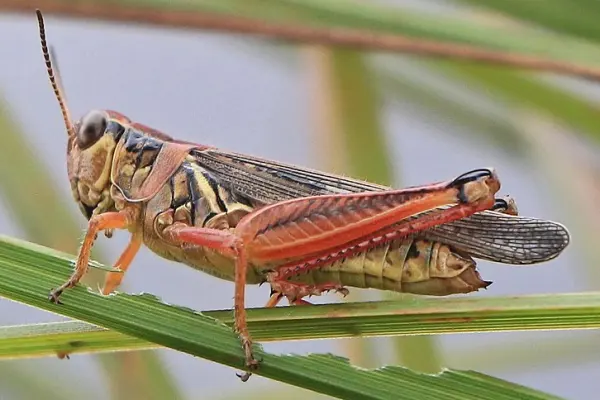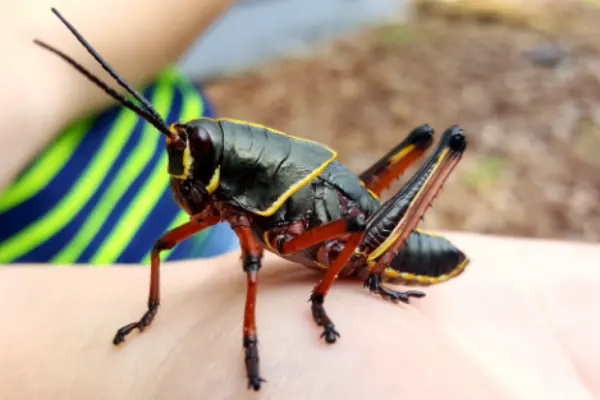Various grasshopper species, such as the immature forms of various locusts, exhibit the green to red color change of grasshoppers during their maturity phase.
The green color is frequently present when grasshoppers hatch from their eggs, but when it grows and develops while going through numerous molting stages, undergoing physiological changes.
Some grasshoppers may progressively turn from green to red or reddish-brown throughout this transition. In this article, we are going to talk about these red grasshoppers. So, let’s begin the article on, “8 Striking Red Grasshoppers in Nature.”
Red Grasshoppers in Nature
1) Red Milkweed Locust

| Scientific Name | Phymateus morbillosus |
| Size | 40-70mm |
| Location | South Africa |
| Identification | Red bodied Grasshopper, feeds on milkweed plants |
Phymateus morbillosus, often known as the red milkweed locust, is an intriguing insect that can be found in some parts of South Africa. The unique red hue of this species of locust serves as a deterrent to predators about its possible toxicity.
The milkweed plants that are an essential component of the red milkweed locust’s food and habitat gave rise to the name “red milkweed locust.”
These locusts consume the milky sap that milkweed plants generate, which is poisonous, rendering the insects deadly to many predators.
Red milkweed locusts are a distinctive and significant element of the South African ecology due to their striking coloration and specific feeding habits.
2) Red-Legged Grasshopper

| Scientific Name | Milanoplus femurrubrum |
| Size | ~1 inch |
| Location | United States, Mexico, and South Canada |
| Identification | Grasshopper with Red legs |
The red-legged grasshopper, technically known as Melanoplus femurrubrum, is a widespread species in the United States, Mexico, and other parts of the world. The name of this grasshopper comes from its unusual reddish-brown legs, which stand out against its green or brown body.
It is a medium-sized bug recognized for its exceptional jumping ability and quick motions. Herbivores, red-legged grasshoppers graze mostly on grasses, leaves, and other vegetation.
They serve an important role in the ecology as both consumers and prey, helping to plant population balance and providing food for numerous predators. Overall, The red-legged grasshopper is a ubiquitous and intriguing sight in landscapes due to its brilliant colours and ecological relevance.
3) Giant Red Winged Grasshopper
| Scientific Name | Tropidacris cristata |
| Size | 14cm in length and 24cm in wingspan |
| Location | Central and South America |
| Identification | Red hue wings, brown, green, reddish body |
The impressive insect species known as the enormous red-winged grasshopper, or Tropidacris Cristata, can be found across the tropical world. This grasshopper is unique due to its extraordinary size and vivid red wings, as suggested by its name.
One of the biggest species of grasshoppers in the world, the enormous red-winged grasshopper can grow up to six inches or more in length. Along with their bright red coloring, their wings frequently have elaborate patterns and motifs that enhance to their visual appeal.
This grasshopper, despite its intimidating size, is a herbivore and consumes a variety of plants, including leaves, flowers, and fruits. The huge red-winged grasshopper’s extraordinary size and distinctive look make it an amazing and fascinating insect in tropical habitats.
4) Female Spotted Bird Grasshopper
| Scientific Name | Schistocerca lineata |
| Size | 33-51mm |
| Location | United States and Northern Mexico |
| Identification | Red Base Body, wings with shade of shades of green or brown |
The spotted bird grasshopper, scientifically known as Schistocerca lineata, is an enthralling and well-known species found throughout North America. This grasshopper species has unique characteristics and behavior that set it apart from other insect species.
The term “spotted bird grasshopper” comes from the stunning patterns and red colors on its body, which resemble the delicate markings of a bird’s plumage.
These marks are often black or dark brown patches on a lighter backdrop, giving them a stunning and distinct appearance.
Furthermore, the spotted bird grasshopper is recognized for its excellent leaping abilities, which allow it to move quickly through its grassy surroundings. It eats a range of flora as a herbivore, including grasses, leaves, and crops.
5) Eastern Lubber Grasshopper

| Scientific Name | Romalea microptera |
| Size | 50-70mm |
| Location | North America |
| Identification | Yellow with Red and Black spots |
The Eastern lubber grasshopper, or Romalea microptera as it is known scientifically, is a stunning and distinctive grasshopper species that may be found throughout the southeast of the United States and known for being huge and having a distinctive coloring, which makes it simple to identify.
The Eastern lubber grasshopper has a substantial body and small wings, which prevent it from flying. A striking and contrasting design is created on its body by the unique blend of brilliant yellow, red, and black.
Due to the poisonous compounds, it acquires from the plants it consumes, this vivid coloring warns potential predators that the animal is unappealing.
The Eastern lubber grasshopper mostly consumes different types of vegetation, such as grasses, leaves, and flowers. It is a somewhat sluggish-moving insect that relies on its obvious appearance to move despite its brilliant appearance.
6) Madagascar Desert Locust

| Scientific Name | Schistocera gregaria |
| Size | 7cm |
| Location | Africa and Middle East Asia |
| Identification | Red wings with black spots |
The desert locust (Schistocerca gregaria) is a well-known and highly destructive insect species found in Africa, the Middle East, and Southwest Asia. The desert locust’s vivid crimson wings are one of its distinguishing features.
While the body of the desert locust is normally brown or yellowish-brown, the mature locust’s wings have a brilliant red color.
These crimson wings have several functions. For starters, they aid in mate attraction and recognition, letting males and females recognize one another during swarming and mating seasons.
Furthermore, the locust’s red color serves as a warning signal to potential predators, suggesting its unpalatability and potential toxicity.
7) Koppie Foam Grasshopper

| Scientific Name | Dictyophorous spumans |
| Size | 80mm |
| Location | Africa |
| Identification | Red legs, frothy foam like secretion |
The intriguing and distinctive Koppie foam grasshopper, technically known as Dictyophorus spumans, is a species of grasshopper that lives in the desert areas of southern Africa. It gets its name from the foam-like secretion that it makes and uses to cover and protect its body.
The Koppie foam grasshopper exhibits an amazing adaption in which it secretes frothy foam from specialized glands near its abdomen. This foam in turn, protects the grasshopper from desiccation and potential injury by acting as a physical barrier against predators.
The Koppie foam grasshopper has a distinctive appearance in addition to its foam protection mechanism. It has brilliant red or orange markings on its belly and legs and a body that is normally dark brown or black.
The ability of the Koppie foam grasshopper to produce foam and its distinctive coloration makes it a unique insect in nature.
8) Rusty Red Grasshopper
| Scientific Name | Chortophaga virdifasciata |
| Size | 20-30mm |
| Location | North America |
| Identification | Brick Red-Coloured body |
The rusty red grasshopper, Chortophaga viridifasciata, is a fascinating insect species found in a variety of grassy settings across North America.
This grasshopper is distinguished by its distinctive rusty red color, which distinguishes it from other grasshopper species.
Its body is covered in brilliant tones of red ranging from rusty brown to deep crimson, which makes for an eye-catching visual spectacle.
In addition it has eye-catching hue, the rusty red grasshopper has dark bands or stripes across its body, which adds to its distinctive appearance.
These markings act as camouflage, allowing the grasshopper to blend in with its surroundings and avoid potential predators. It adds beauty and complexity to the North American grasslands with its attractive rust-colored body and crucial ecological significance.
Conclusion
These were some of the striking red grasshoppers found in nature. Overall, the prevalence of red grasshoppers in nature demonstrates these insects’ amazing diversity and resilience. Their vibrant colors not only provide visual appeal, but also perform crucial purposes such as signaling predators and providing concealment in their settings. Grasshopper coloration and development research continues to advance our understanding of their biology, ecology, and evolutionary adaptations.
References
- https://www.inaturalist.org/guide_taxa/1669056
- https://www.projectnoah.org/spottings/17779314
- https://www.whatsthatbug.com/koppie-foam-grasshopper/
- https://mdc.mo.gov/discover-nature/field-guide/red-legged-grasshopper
- https://thejungleexplorer.com/gallery/insect-photos/giant-red-winged-grasshopper-tropidacris-cristata
- https://fieldguide.mt.gov/speciesDetail.aspx?elcode=IIORT59110
- https://www.britannica.com/animal/short-horned-grasshopper#ref290882
- http://m.desertlocust-crc.org/Pages/About.aspx?id=127&lang=EN&I=0
- https://www.sanbi.org/animal-of-the-week/desert-locust/#:~:text=Picker%20et%20al.,known%20to%20occur%20in%20Africa.
- https://bugguide.net/node/view/292498
Also Read:

I am a person who effortlessly combines creativity, hard work, and a strong interest in nature. My writing takes you on incredible journeys where science and imagination come together. I am driven by a deep curiosity to understand the wonders of life, and dive into the details of biology with thorough research and a genuine appreciation for nature. My articles are full of vivid descriptions and fascinating facts, making the world of biology come alive. Whether I am writing articles, essays, or fiction, my work sparks curiosity and shows the incredible beauty of our natural world.
